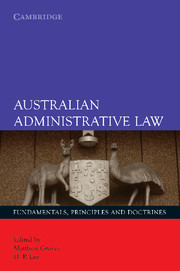Book contents
- Frontmatter
- Contents
- Foreword
- Preface
- About the contributors
- Table of cases
- Table of statutes
- 1 Australian administrative law: The constitutional and legal matrix
- 2 Administrative law in Australia: Themes and values
- 3 The public/private distinction in Australian administrative law
- 4 Australian administrative law: The human rights dimension
- 5 Administrative tribunals
- 6 Australian Ombudsman: A continual work in progress
- 7 Freedom of information
- 8 Delegated legislation
- 9 The concept of ‘justiciability’ in administrative law
- 10 Standing
- 11 Reasons for administrative decisions: Legal framework and reform
- 12 Relevant and irrelevant considerations
- 13 Improper purpose
- 14 Reasonableness, rationality and proportionality
- 15 The ‘no evidence’ rule
- 16 Failure to exercise discretion or perform duties
- 17 Procedural fairness: The hearing rule
- 18 The doctrine of substantive unfairness and the review of substantive legitimate expectations
- 19 The impact and significance of Teoh and Lam
- 20 The rule against bias
- 21 Jurisdictional error without the tears
- 22 Privative clauses and the limits of the law
- 23 Administrative law judicial remedies
- Endnotes
- Index
9 - The concept of ‘justiciability’ in administrative law
Published online by Cambridge University Press: 05 June 2012
- Frontmatter
- Contents
- Foreword
- Preface
- About the contributors
- Table of cases
- Table of statutes
- 1 Australian administrative law: The constitutional and legal matrix
- 2 Administrative law in Australia: Themes and values
- 3 The public/private distinction in Australian administrative law
- 4 Australian administrative law: The human rights dimension
- 5 Administrative tribunals
- 6 Australian Ombudsman: A continual work in progress
- 7 Freedom of information
- 8 Delegated legislation
- 9 The concept of ‘justiciability’ in administrative law
- 10 Standing
- 11 Reasons for administrative decisions: Legal framework and reform
- 12 Relevant and irrelevant considerations
- 13 Improper purpose
- 14 Reasonableness, rationality and proportionality
- 15 The ‘no evidence’ rule
- 16 Failure to exercise discretion or perform duties
- 17 Procedural fairness: The hearing rule
- 18 The doctrine of substantive unfairness and the review of substantive legitimate expectations
- 19 The impact and significance of Teoh and Lam
- 20 The rule against bias
- 21 Jurisdictional error without the tears
- 22 Privative clauses and the limits of the law
- 23 Administrative law judicial remedies
- Endnotes
- Index
Summary
The term ‘justiciability’ refers to the suitability for, or amenability to, judicial review of a particular administrative decision or class of decisions. The term derives from the common law and reflects a series of self-imposed judicial restraints, themselves founded in a view as to the appropriate constitutional balance between the respective roles of the Executive and the judiciary. Thus, a matter may be deemed ‘non-justiciable’ by a court which feels that its resolution either is beyond the institutional competence of the court or would involve stepping outside the bounds of its appropriate constitutional role.
There is a good deal of confusion surrounding justiciability. At least in part, this is due to the fact that the term is used in a number of discrete, albeit sometimes overlapping, senses. It is important to keep these various strains of meaning analytically separate. Some are best analysed quite separately from justiciability in its strict sense. The following senses of the term may be encountered from time to time:
1) The matter is beyond the jurisdiction of the court;
2) The matter is within the jurisdiction of the court, but beyond the reach of the prerogative writs or their equivalent administrative law remedies, as it does not involve an exercise of ‘public’ power;
3) The court possesses jurisdiction but is institutionally incompetent to resolve the matter;
4) The court possesses jurisdiction and is competent, but regards the matters as constitutionally inappropriate for its intervention;
5) The court views the matter as premature, and thus not yet appropriate for judicial intervention;
6) The court can find no ground of review, or at least no argument that would not involve an impermissible intrusion into the administrative merits;
7) […]
- Type
- Chapter
- Information
- Australian Administrative LawFundamentals, Principles and Doctrines, pp. 143 - 157Publisher: Cambridge University PressPrint publication year: 2007
- 1
- Cited by



